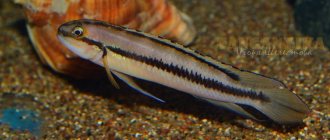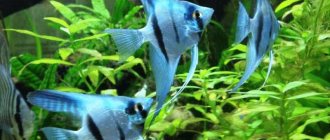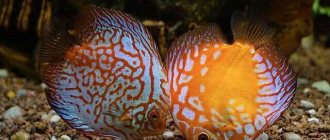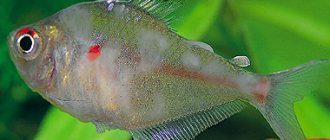Tilapia is a representative of African water bodies from the family Cichlidae and the order Perciformes, common in Mozambique. It lives in fresh water, but can spend some time in salt water. It is bred by both aquarists and commercial fish farmers for food consumption. There are more than 70 species of aquarium tilapia.
The history of the origin of tilapia dates back to ancient times, tilapia is known as a sacred animal in the culture of Ancient Egypt, and also as the “fish of St. Peter”. By nature, the fish is energetic, active and cheerful, completely unpretentious in breeding. The most popular types of ornamental tilapia are Mozambique, zebra, Nile and tiger.
External structure
Tilapia has a tall body, drawn together at the sides, reaching 40 cm in nature, but in aquariums the common tilapia grows up to 20 cm. It is a fish with a large head and mouth, whose jaws are long and strong, and whose lips are full.
The color of tilapia is mostly gray-greenish, acquiring a yellowish tint with age. It intensifies its color when excited. During the spawning period, the body darkens significantly and acquires a black tint, but the throat remains white. The natural type of tilapia has red stripes along the edges of the fins, but today artificial specimens with pink or yellow coloring have also been bred.
The difference between the male appears in the form of multiple milky spots on the caudal fin and larger body sizes. Male tiger tilapia have 5-6 black spots on the sides, and a pink tint on the throat.
Return to content
Zebra tilapia (Heterotilapia buttikoferi)
Zebra tilapia, or disk tilapia (Zebra tilapia), majestically slides between snags and thickets of plants, skirting intricately laid stone slabs. Her black and white body either merges with the general background or stands out sharply against it. A small sharp snout smoothly turns into a convex forehead, long thread-like ventral fins seem to impatiently stir up small pebbles.
You raise your hand to the aquarium, and all shades of color instantly run across the body of the fish: against a light background - from gray to shimmering white - a dense intersection of black vertical stripes, turning into an orangeish edging of unpaired fins, stands out.
It's feeding time, and the male comes out to check his territory. Attracted by the splashes, the female swims out from under the snags. She is smaller, more angular, although she is not inferior in color to the male. A flock of fry, like two peas in a pod, are propped up from behind. Some of them swim forward, but the female, with some subtle movements, immediately drives them back. Despite the fact that the fry have already reached 4-5 centimeters, a caring mother still takes care of them.
The male greedily bites into a lump of bloodworm. The female also gets her share. And below, near the ground, the juveniles are swarming, hastily swallowing the food falling to the bottom.
Related article Mozambique tilapia (Oreochromis mossambicus)
Having had their fill and majestically paraded at the viewing glass, the fish swim away beyond the granite ridges - either in search of something edible, or simply tired of the bustle of the day.
Zebra tilapia was brought to the Moscow Zoo Aquarium from Germany in 1988.
In nature, in the waters of West Africa, tilapia grow up to 30 centimeters. Our new residents were significantly smaller. They had a lively disposition and stuck their noses everywhere. Having quickly become accustomed to the 150-liter hygienic aquarium, they swam up and down together. Preference was clearly given to animal food: daphnia, tubifex, bloodworms. The temperature was maintained at 27°C. There were no shelters. A little table salt was added to the water and methylene blue was added (until it acquired a blue color).
In one and a half to two months, the fish approximately doubled in size, reaching a length of 10-12 centimeters with a body height of 6-8 centimeters. We had to choose a more spacious home for them.
For this purpose, an exhibition 300-liter aquarium was prepared with a sufficient number of shelters - stones, driftwood, flower pots with broken edges or without a bottom, drainage tubes, etc. Shelters were vital, since the grown tilapia had already begun to show their character; however, it did not lead to serious damage. Planted at the end of summer, they lived peacefully until the spring of next year. By this time, their length had already reached almost 18 centimeters.
By the end of spring, the fish began to divide into pairs. The first pair to leave, apparently due to lack of living space, unexpectedly killed the two smallest individuals and thoroughly bit the rest. It should be noted that the jaws of zebra tilapia are armed with a number of conical teeth, which pose a danger to the small inhabitants of the aquarium. It was decided to leave the couple alone. But the expected spawning never happened. The next morning the female was found dead at the surface of the water.
The remaining tilapia, a male and three females, did not get along well with each other and had to be separated.
And only two years later, when the fish had finally formed and began to show activity, the question of breeding them arose. Tilapia were fed with bloodworms, large daphnia, live and frozen fish, finely chopped meat, and squid fillets. The temperature was maintained within 26-28°C.
The fish were placed in a 400-liter aquarium, divided into three parts by partitions.
After special manipulations with the females and daily replacement of part of the water (about a quarter of the volume), it became clear that one of them was ready to spawn. This was evident from the large tube-shaped ovipositor.
The behavior of the male zebra tilapia also changed. He no longer threw himself at the plexiglass partition, fiercely biting into it, but only played with his fins in front of the female and actively cleaned the stones in his compartment with his mouth. Circling around the partition, he seemed to check whether there was a gap somewhere, and from time to time he froze in place, spreading his fins, which made him seem even wider and larger.
Two days later the partition was removed.
Zebra tilapia are lithophiles; in nature, they lay eggs on a hard substrate. Our couple was given a wide choice - from a huge (30 centimeters in diameter) flower pot without a bottom to a block of shell rock.
After swimming a bit, the producers cleaned all the items one by one and were finally tempted by a flower pot. The male cleaned out the entire inside of it within an hour. The temperature was gradually raised to 30°C, after which spawning began. The fish became almost white with rare black and gray stripes and stains. Spawning lasted about three hours. In the evening, the entire pot, strewn with brownish eggs, was transferred to a previously prepared 60-liter aquarium incubator. There were almost no whitened unfertilized eggs.
Water parameters in the incubator: hardness 12°, pH 6.8-7.5, temperature 30°C (a small amount of methylene blue solution was added to the water). Aeration and filtration were carried out by two sponge filters placed in different corners of the aquarium. They created water circulation using a powerful air current.
Three days later, the fluffy carpet of larval tails on the walls of the pot began to move.
Related article Tiger tilapia (Pelmatolapia mariae)
A week later, more than 700 fry swam around the aquarium, actively absorbing live dust. And then another interesting feature of these tilapia was revealed: glowing, neon-like eyes and a flickering stripe on the dark abdomen.
At the age of one month, the juveniles acquired the coloration of adult fish. Around the same time, the spawners spawned for the second time.
Part of the clutch was left in the spawning area, and selfless parents protected their offspring until they were one and a half months old, fearlessly throwing themselves onto a hand or hose.
Young tilapia had two color options. Some were striped, others had a blurry pattern (black and white stripes merged into bizarre patterns, like those of juvenile astronotus).
Fans of large cichlids who decide to keep these tilapia at home should remember that to keep them they need a large (at least 200 liters) aquarium. It is better to place one couple in it, then their individual characteristics will be more fully revealed. The pair should stand out from a flock of 7-10 individuals.
Zebra tilapia can be kept with any large fish (except during the spawning season). In the Aquarium of the Moscow Zoo, 6-7 cm juveniles get along well with large species of Tanganyika lamprologus and Malawian cirtocarus. They are unpretentious in food, preferring animal food. The fish do not touch the plants, but to avoid undermining the roots, it is better to surround the bush with large stones. Plants with a good root system, tough leaves and firm stems are desirable. The optimal soil is fine gravel, lightly sprinkled with a layer of larger stones.
Source: S. Elochkin, Aquarium magazine, 1994 - 1
Content
The fish are easy to care for, but require space in the aquarium. Tilapia is a territorial creature, so it is best to keep it in a species aquarium with other cichlids. In a community aquarium, a fish may become aggressive towards other fish, defending its shelter.
The optimal volume of an aquarium is 100 liters with a water temperature of 20-35°C, pH7-8.5, hardness 4°-15° with filtration and aeration. Although the composition of the water does not play a special role, since tilapia has endurance and resistance to chlorine impurities. In a small aquarium, males will not be able to create hiding places for their females, which will provoke fights among them.
The fish does not need plants; it is better to lay out driftwood, labyrinths and stones in such a way as to provide shelter for the females. Mixed soil, fine gravel, pebbles and sand. The lighting is dim, the corners are shadowed. A 1/4 fresh water change should be done weekly.
Return to content
Reproduction
Tilapia is ready to spawn at 10 months of age under good environmental conditions. This fish has various options for storing eggs. Often females lay eggs on smooth stones or leaves without growths. Others spawn in holes specially dug by them or their partner.
But there is an individual feature inherent in this fish - storing caviar in the mouth. First, the female digs a hole at the bottom into which she lays her eggs, after which the tilapia collects them in her mouth for the entire incubation period. After 2 weeks, the fry emerge, and if there is no danger around, they frolic and feed on zooplankton, brine shrimp and cyclops.
The fry will be protected from various diseases, since the mucous membrane of tilapia secretes a special secretion that affects pathogens. By sorting the eggs in its mouth, tilapia separates the healthy from the weak, releasing strong offspring into the world. During incubation, the female abstains from food.
In preparation for spawning, the males begin their games, chasing the female throughout the aquarium and choosing a place to build a nest. There he digs a hole, which can be up to 20 cm in diameter.
Tilapia does not require a separate aquarium for spawning and the water parameters do not need to be changed. The fish form long-term pairs and the parents take care of their offspring together. Adult females are capable of laying 1000 or more eggs.
Return to content
Zebra tilapia or Tilapia buttikoferi
The habitat for fish of the species Zebra Tilapia or Buttikoferi Tilapia (Tilapia buttikoferi), or as it is also called discoid Tilapia, can be either fresh or water with a high level of salt. This species is found in West Africa, or more precisely in Liberia. Ancient African tribes eat it as food, and among fish lovers it is popular for its attractive coloring and entertaining habits.
Characteristics of the species
Tilapia Buttikofera (another variant of the name Zebra tilapia) has the following characteristics:
Oval, elongated shape. Large mouth and plump lips. The gray body of the fish is dissected by dark stripes. The edging of the unpaired fins is colored orange. Subtle differences between males and females. Among them is that females are less richly colored and inferior to males in size. Dimensions in the wild reach 30 cm. Dimensions in aquarium conditions reach 20 cm.
The Zebra Tilapia's character is peaceful most of its life. Aggression and irritability can be noticed only in the pre-spawning period, while protecting the place where the eggs are laid.
Content
Representatives of Tilapia buttikoferi have high tolerance to other species of the same or larger sizes. However, if you want to get Tilapia, you need to remember that fish are inherently territorial, and males often fight for their own area. Therefore, an important recommendation for their maintenance is to place no more than one pair in one aquarium.
For a comfortable existence, one pair of Buttikofer Tilapia will require an aquarium with a volume exceeding 200 liters. When arranging it, it is worth paying attention to the fact that fish of this species love to feast on various plants. Therefore, it is better to use decorative rather than natural vegetation for decoration.
For tilapia to live comfortably, zebra water must have certain characteristics, such as:
Temperature within 20−25°C Hardness dH, 6−25° Acidity pH, 6.4−7.7
Approximately 20% of all aquarium water should be regularly updated with fresh water of the same characteristics. It is also necessary to filter it for purification and aerate it to saturate it with oxygen.
Fish also need to prepare a variety of shelters to create nests during spawning, which they will protect and clean. One option would be to turn flower pots on their side so that fish can swim into the hole.
Under artificial conditions, Tilapia Buttikofera feeds on animal feed. As a substitute, you can use flake and granular dry food, but the fish may not like them very much.
Reproduction
Zebra tilapia reaches sexual maturity at 6-7 months after birth.
Spawning, as a rule, takes place in an aquarium of permanent residence of fish. Usually the offspring are not disturbed and are protected for a long time. Telapia eggs are not incubated in the mouth, but are deposited on a substrate selected by them, which is subsequently aggressively protected from external irritants and strangers.
An increase in the brightness of the male's color and the rounding of the female's abdomen signal the approaching spawning. During this period, the male does not leave the place chosen for laying and fiddles with cleaning it.
The impetus for spawning can be an increase in temperature by several degrees. This is usually used to artificially approximate the process. Spawning usually takes several hours. During this time, the female manages to reproduce 500-700 eggs. After 2-3 days, the larvae hatch, and after several days the fry are born. In the first month after birth, the fry will begin to acquire their parental colors.
In aquarium conditions, Tilapia Buttikofera can live from 10 to 12 years.











